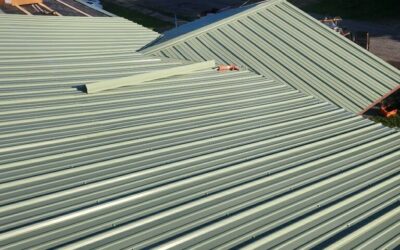Why Commercial Roofing and Siding Work Together
When most commercial property owners think about exterior building protection, they tend to focus on the roof. While the roof is absolutely essential for defending the structure against weather, leaks, and damage, it is only half of the equation. Commercial siding plays a powerful supporting role in keeping a building safe, efficient, and structurally sound. Roofing and siding are not separate systems—they work together as a single protective envelope that shields everything inside your commercial building.
Understanding how these two components depend on each other can help you avoid expensive repairs, prevent water intrusion, improve energy efficiency, and extend the lifespan of your entire property. Below is a comprehensive look at why commercial roofing contractors and siding must be viewed as a unified system and why investing in both is critical for long-term building performance.
1. Together, Roofing and Siding Form the Building Envelope
The most important reason commercial roofing and siding work together is that they create the building envelope—the barrier that separates the interior from exterior weather conditions. The envelope must remain strong, sealed, and continuous to prevent:
- Water leaks
- Air drafts
- Moisture penetration
- Heat loss
- Structural deterioration
When the roof and siding are in good condition and properly connected at all seams, edges, and transitions, the building envelope performs at its best. But when one system begins to fail—whether it’s cracked siding panels or aging roofing material—the other system is always impacted.
A roof can be brand new, but if the siding is rotted or pulling away, water can still enter. Similarly, new siding won’t fully protect the building if the roof is leaking into wall cavities. The two must be maintained together.
2. Proper Water Management Depends on Both Roofing and Siding
Water is the number one enemy of commercial buildings. Flat roofs, low-slope roofs, and large commercial rooftops depend heavily on precise drainage systems to direct water away. But roofing alone cannot manage water correctly—siding plays a critical role in directing water down and away from the structure.
Here’s how the two work together:
- The roof channels water to gutters, drains, or scuppers.
- Siding helps guide that water away from the walls and foundation.
- Flashing connects the roof and siding at edges, preventing leaks.
- Wall-to-roof transitions must be sealed to keep water out.
- Siding prevents wind-driven rain from entering behind the roofing system.
If either system has gaps, cracks, holes, or poor flashing, water will infiltrate the structure. This can lead to:
- Mold growth
- Rotted framing
- Damaged insulation
- Wall deterioration
- Interior water stains
- Commercial equipment damage
- Costly structural repairs
A roofing contractor who understands siding—and vice versa—can ensure both systems are working together to keep moisture out.
3. Siding Helps Protect the Roof Structure From Wind
Strong winds in commercial areas can create intense pressure differences around large buildings. While roofing systems are engineered to handle wind uplift, siding helps stabilize the walls beneath the roof.
If siding is damaged, loose, or deteriorating:
- Wind can enter behind panels
- Pressure can build beneath the edges of the roof
- Uplift forces increase
- Membranes, shingles, and panels become vulnerable
This means that siding issues can directly contribute to roofing failures. Combined roofing and siding maintenance ensures your building is better protected during storms and high-wind events.
4. Both Impact a Building’s Energy Efficiency
Energy efficiency is a major concern in commercial buildings, especially those in climates with extreme heat or freezing temperatures. Roofing and siding work together to regulate heat transfer and prevent energy loss.
Roofing contributes by:
- Reflecting UV rays
- Preventing heat absorption
- Insulating the top of the building
- Keeping temperatures stable
Siding contributes by:
- Insulating the walls
- Preventing air leaks
- Reducing thermal bridging
- Keeping interior temperatures consistent
If either system is outdated or damaged, your building loses heat in winter, gains heat in summer, and runs up unnecessary energy costs. A strong roof paired with high-quality siding creates a complete insulation barrier that keeps utility bills lower and indoor conditions comfortable.
5. Flashing and Transitions Must Be Coordinated
One of the most important but overlooked aspects of commercial roofing and siding is flashing—the thin metal or waterproof material installed where two surfaces meet. Flashing is commonly found:
- Where the roof meets a wall
- Around windows
- Around HVAC units
- Around parapet walls
- Along edges and corners
Roofers typically handle the top flashing, while siding professionals handle wall flashing. If these two teams are not coordinated, gaps or overlaps can occur—leading to leaks.
A properly executed commercial installation ensures:
- No gaps in the building envelope
- Seamless water protection
- Correctly layered flashing systems
- Complete adherence to manufacturer warranties
Flashing is one of the biggest reasons roofing and siding must be installed with a unified plan.
6. Combined Maintenance Extends the Lifespan of the Entire Building
Regular maintenance on just the roof or just the siding is not enough. Buildings function as systems, and neglecting one area affects the others.commercial roofing services
Roof maintenance typically includes:
- Removing debris
- Inspecting membranes
- Checking drains and scuppers
- Sealing seams and flashings
- Repairing punctures or cracks
Siding maintenance includes:
- Checking for cracks or gaps
- Inspecting panels for warping
- Repainting or resealing materials
- Evaluating insulation and moisture barriers
- Ensuring proper fastening
Combined maintenance prevents:
- Water infiltration
- Mold growth
- Structural rot
- Early system failure
- Increased repair costs
- Voided warranties
A building that is well-maintained from roof to siding performs better, lasts longer, and costs less to operate.
7. Roofing and Siding Affect a Commercial Building’s Curb Appeal
Commercial buildings need strong curb appeal—whether you’re attracting customers, tenants, or clients. A roof and siding that are worn, stained, rusted, or visibly failing can negatively affect your business image.
Updating both systems together creates:
- A unified aesthetic
- A cleaner, more professional appearance
- Higher property value
- Better first impressions
- Compliance with local building requirements
Many commercial clients find that updating both the roof and siding at the same time offers the best return on investment.
8. Coordinated Roofing and Siding Projects Save Money
When roofing and siding are replaced or repaired together, commercial property owners benefit financially. Coordinating both systems reduces costs associated with:
- Labor
- Equipment setup
- Permits
- Material deliveries
- Waste removal
- Downtime for your business
Since crews, dumpsters, lifts, and fencing are often needed for both jobs, combining them can significantly lower the total project cost.
9. The Best Commercial Contractors Understand Both Systems
Not all contractors specialize in both roofing and siding, but the best commercial installers understand how these systems interact. A contractor with experience in both areas ensures:
- Seamless transition points
- Proper flashing installation
- Full building envelope protection
- No warranty conflicts
- Better long-term performance
Choosing a contractor who offers both roofing and siding services ensures a smoother, more coordinated project from start to finish.
Final Thoughts: Roofing and Siding Must Work as One System
Commercial roofing and siding are not isolated components—they are two halves of the building’s protective shell. When they work together, they protect your property from water damage, structural deterioration, weather extremes, and energy loss. When one fails, the other is often compromised as well.
For the strongest, longest-lasting commercial building, roofing and siding must be installed, maintained, and repaired with a unified approach. A contractor who understands both systems can help ensure your building remains structurally sound, energy-efficient, and visually appealing for decades.commercial roof replacement
 (440) 307-2060
(440) 307-2060

